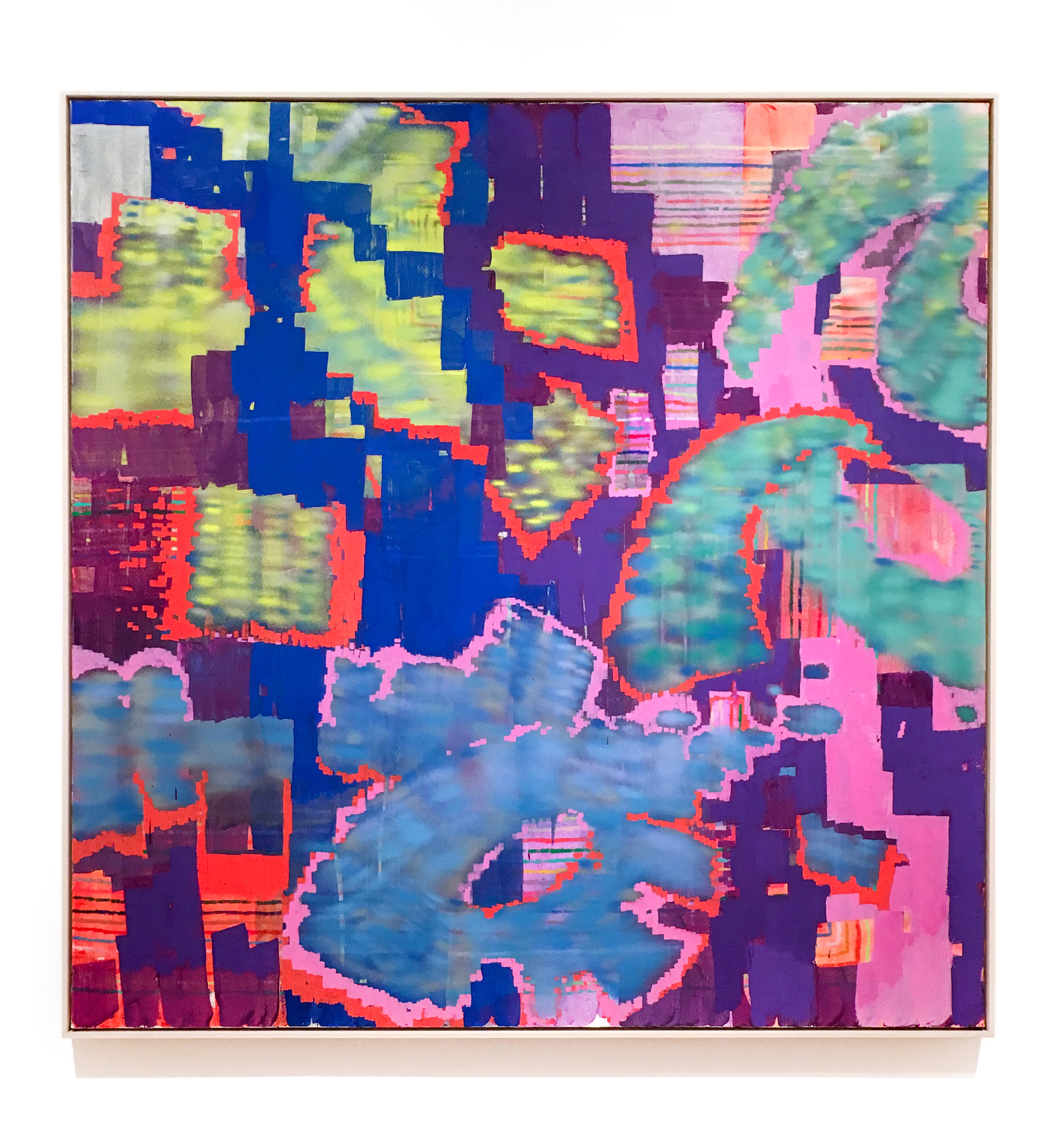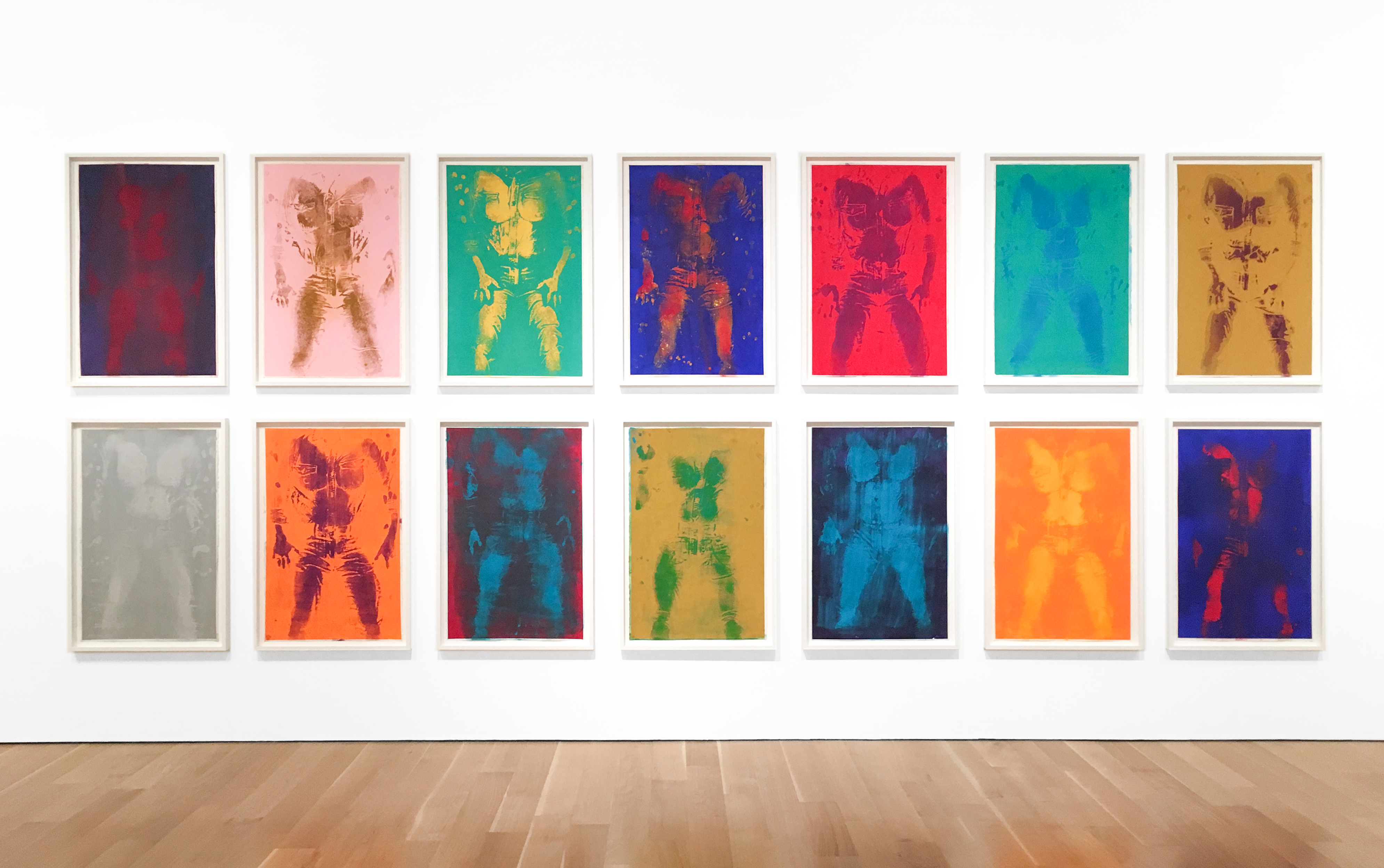
PHOTOS: Courtesy, Ruckus.
︎ Speed Art Museum, Louisville
Keltie Ferris: *O*P*E*N*
The Speed Museum’s winter exhibition Keltie Ferris: *O*P*E*N* is an 8-year comprehensive that showcases New York-based artist and Louisville native Keltie Ferris with a collection of bold abstract paintings and ambiguous body prints. Taken together this show centers on the role artist visibility plays in interpretation, and offers viewers a chance to rethink the need for biography in contemporary art.
The paintings are large and flirt with patterns of pixelated grids and sections of parallel lines made by the swiping of paint Ferris refers to as “erasures.” Also characteristic to this grouping is an improbable and towering impasto that stands an inch or more off the surface of the canvases which is otherwise visually flat. In Surge (2018) these impasto sections are carved into clean and logical shapes which bring them intimately close to the viewer against a backdrop of fuzzy abstractions made with thin brushwork or pigment applied with a spray gun. The impasto extrudes from the canvas surface at 90 degrees and creates its own mesa-like plane. Arranged in interlocking geometries and tight grids, they might read as anything from skyscrapers, keys on a computer keyboard, or odd macarons at a pâtisserie. Regardless, there is an uncertainty of scale between these objects that makes Ferris’ work successful and otherworldly.
The titles of the work also serve to transport the viewer, often including or completely comprising of ASCII characters with titles such as ++++***)))) (2012), or utilizing non-traditional capitalization like in the work scRoll (2017). Both examples of type treatment suggest a connection to the early forum-based internet where these motifs were born, one which is reinforced through the color schemes and patterning reminiscent of this era (think no further than the Windows 95 logo). While comparing Ferris’ work to technology feels straightforward, attempting to compare the artist’s oeuvre to anything familiar also seems besides the point. The wall text for the painting Clocked (2015) - a work that is particularly evocative of computer graphics - includes a complicating comment from Ferris about the connection to technology and his work: “Painting has always been interpreted through the technologies of its time...but it is problematic to allow the media of the moment to eclipse other possible interpretations.”
The indefinite nature of these interpretations is what lends abstraction its power and its constraints. Ferris’ paintings could (and perhaps should) be of anything, but there is a limit to how specific messaging can be with this kind of work. This makes the photographic “body prints” that comprise the other half of the show all the more interesting a compliment. If the interpretive script of the paintings belong to the audience, the artist’s body prints are carefully written performances of revealing and concealing. The prints are made by dusting pigments onto layered impressions left by Ferris’ upper body on paper with an oil medium. They are a subtle mixture of skin and clothes that render an androgynous form in an x-ray effect which feels voyeuristic, archaeological, and fantastic all at once. While clearly being of “someone,” common metrics of identity offer little epistemological clarity.
In the introduction to Opacity and the Closet, Queer Tactics in Foucault, Barthes, and Warhol, queer theorist Nicholas De Villiers explores the limits of the “closet” metaphor, and thus, the larger queer obligation to reveal oneself. He writes that homosexuality and queerness “is treated as an object of knowledge, something spoken about, rather than as a positionality from which it is possible to know and to speak. A queering of biographical forms is therefore a crucial strategy.” The body prints are an exploration of this strategy and principle. Ferris noted in an interview with The Brooklyn Rail that “people are obsessed with the maker. The biographic thing where women painters are paired together, young are separated from the old, all of that is so anti-art to me. There is an element to the body prints that was just like, ‘If you want to know about me, here I am.’” Ferris goes on to say, “You see everything, but you don’t. That kind of controlled unfurling is queer.”
While *O*P*E*N* is not the first major exhibition in Louisville this year to include themes of identity, opacity, and visibility, other efforts have been heavy-handed, at best, and difficult to follow. In *O*P*E*N* there is a unique clarity and richness to the work put forth by Keltie Ferris, as well as his notions of what it means to be an artist. The show feels both present and playfully evasive, while maintaining a fresh and believable sincerity. For either a Louisvillian, or a visiting patron of the Speed Art Museum, there is an inescapable intrigue about the person of Keltie Ferris. Nonetheless, the questions that are raised about his story are going to reveal much more about their inquisitor than anything about the artist himself.
-
Keltie Ferris: *O*P*E*N* is on display on the second floor of the Speed Art Museum through February 3, 2019.
The Speed Art Museum is located at 2035 South Third Street, Louisville, Kentucky 40208.
Notes:
- Speed Art Museum
- The Brooklyn Rail
- De Villiers, Nicholas. Opacity and the Closet, Queer Tactics in Foucault, Barthes, and Warhol. University of Minnesota Press, 2012.
L Autumn Gnadinger, Contributor to Ruckus
11.25.18
Article last updated 4.26.21

Surge (2018). Oil and acrylic on canvas.

Siasec Yem (2012). Oil and acrylic on canvas.

Prince (2013-14). Oil and powdered pigment on paper.

[M][O][V][E][M][E][N][T] (2018). Oil and powdered pigment on paper.

Clocked (2015). Oil and acrylic on canvas.







